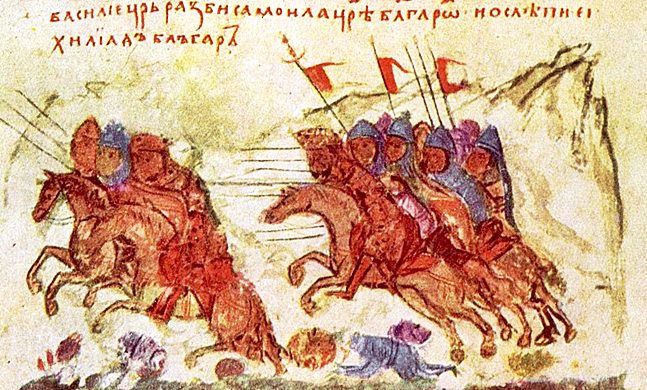
Battle of Setina |
year: 1017Autumn 1017 |
| A victory of the Byzantines over the Bulgarians | ★ ★ ★ ★ ★ |
|
enemy: Bulgarians
|
location: Near the village Skopos (old name “Setina”) in Florina region of north Greece
|
accuracy:
●●●●●
|
|
battle type: Pitched battle |
war: Conquest of Bulgaria |
modern country:
Greece |
| ▼ The Byzantines(emperor: Basil II Bulgaroktonos) | ▼ The Enemies | |
| Commander: | Emperor Basil II | Tsar Ivan Vladislav |
| Forces: | ||
| Losses: |
| Background story: |
| In 1014, after the victory of the Byzantines at Kleidion and the death of Tsar Samuil, the Bulgarians were in a dire situation. The Byzantines now had the initiative and were invading constantly into the territory of the enemy. In the meantime, in August 1015, Ivan Vladislav had become the tsar of Bulgaria, having assassinated his cousin Gabril Radomir. Vladislav at first pretended to consider capitulation, but quickly organized his defense. The voivode Ivats defeated a large Byzantine force near Vitolia (Bitola) and in this way the occupation of the capital Ohrid by the Byzantines was averted. At the same time, the new tsar undertook an effort to reorganize the Bulgarian defense and repair castles. Nevertheless, the Byzantines managed to capture several fortresses in 1015. In 1016 they had a serious failure when they failed to capture the strong fortress of Pernik in present-day western Bulgaria, although they besieged it for 88 days. After that, the Bulgarians counterattacked and were able to retake some castles. In 1017 the tireless emperor Basil II campaigned again. This time he besieged Kastoria. During the siege, information came that the governor of Pernik Krakras was planning to attack northeastern Bulgaria, which had been occupied by the Byzantines since 1001. This move was supposed to have been made in cooperation with the Pechenegs who at that time lived north of the Danube. When the emperor learned of this development, he immediately abandoned the siege of Kastoria and hurried north to check the situation. However, the Pechenegs refused to cooperate with the Bulgarians (perhaps due to the immediate reaction of the Byzantines) and the Bulgarian attack on the northeast did not take place. So Basil and his army took the road back to western Macedonia. |
The Battle: |
 The Bulgarians under the leadership of Tsar Ivan Vladislav marched against the Byzantines in Setina. Basil, possibly underestimating the threat, sent against the Bulgarians who were approaching a unit (tagma) headed by General Constantine Diogenes (who was Duke of Thessaloniki at that time). This unit fell into an ambush of the Bulgarians and was surrounded. When the 60-year old Basil heard this, he mounted his horse and, saying, “the warriors, follow me” rushed against the enemies. When the Bulgarians saw him marching towards them, they panicked and fled, including the tsar, being chased by Diogenes's unit. They had heavy losses and 200 were taken prisoners. One of them was the nephew of the tsar who was blinded on the spot. Then the Byzantine army withdrew from the area and shortly after, in January 1018 the emperor arrived in Constantinople. |
Noteworthy: |
| Constantine Diogenes, who in 1022 became strategos (governor) of the Thema of Bulgaria, was the father of the emperor Romanos IV Diogenes, the great loser at Manzikert. |
Aftermath: |
| It was a victory that further strengthened the advantage of the Byzantines. It was not decisive, but in fact it was the last worth mentioning battle of the long war with the Bulgarians. The following year in Durres, Tsar Ivan was killed and the Bulgarians finally surrendered. |
|
|
